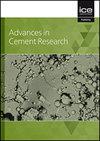Partial replacement of OPC with CSA cements – effects on hydration, fresh-, hardened-properties
IF 1.3
4区 工程技术
Q3 CONSTRUCTION & BUILDING TECHNOLOGY
引用次数: 2
Abstract
The effects of a partial replacement of Ordinary Portland cement (OPC) with three types of calcium sulfoaluminate (CSA) cements (40 wt% and 20 wt%) were investigated. The obtained results were generally in agreement with previously published data but with few interesting exceptions. Setting times were shortened due to the formation of ettringite. The maximum hydration temperature increased for concretes containing 40 wt% of CSA but decreased when 20 wt% replacement was used. The decrease was related to the deficiency of the available sulfates, which limited the formation of ettringite. The presence of extra anhydrite and calcium oxide was associated to the delayed establishment of the second temperature peak in contrast to OPC-based concretes. Their surplus delayed calcium aluminate and belite reactions, and triggered renewed formation of ettringite, C-S-H and portlandite. Effects of aluminum hydroxide were also indicated as possibly important, although not proved experimentally in this research. The slightly lower compressive strength measured for mixes containing 40 wt% of CSA were linked with more formed ettringite. The same factor was indicated as the key to the reduction of the total shrinkage in mixes containing 40 wt% of CSA and increased for the lower CSA replacement level. In that case, the insufficient amount of formed ettringite caused too small expansion, which could not efficiently mitigate or compensate the developed shrinkage.用CSA水泥部分替代OPC -对水化、新鲜、硬化性能的影响
研究了三种类型的硫铝酸钙(CSA)水泥(40% wt%和20% wt%)部分替代普通硅酸盐水泥(OPC)的效果。获得的结果大体上与先前发表的数据一致,但也有一些有趣的例外。由于钙矾石的形成,凝结时间缩短。当CSA添加量为40%时,混凝土的最大水化温度升高,当CSA添加量为20%时,混凝土的最大水化温度降低。这种减少与有效硫酸盐的缺乏有关,这限制了钙矾石的形成。与opc基混凝土相比,额外硬石膏和氧化钙的存在与第二温度峰的延迟建立有关。它们的过剩延迟了铝酸钙和白橄榄石的反应,并引发钙矾石、C-S-H和钾长石的重新形成。氢氧化铝的影响也可能是重要的,尽管在本研究中没有得到实验证明。含有40 wt% CSA的混合物的抗压强度略低,与形成更多的钙矾石有关。同样的因素被认为是减少含40% CSA的混合料总收缩率的关键,并且在CSA替换水平较低时增加。在这种情况下,钙矾石的形成量不足,导致膨胀过小,不能有效地缓解或补偿收缩的发展。
本文章由计算机程序翻译,如有差异,请以英文原文为准。
求助全文
约1分钟内获得全文
求助全文
来源期刊

Advances in Cement Research
工程技术-材料科学:综合
CiteScore
3.70
自引率
5.00%
发文量
56
审稿时长
3.2 months
期刊介绍:
Advances in Cement Research highlights the scientific ideas and innovations within the cutting-edge cement manufacture industry. It is a global journal with a scope encompassing cement manufacture and materials, properties and durability of cementitious materials and systems, hydration, interaction of cement with other materials, analysis and testing, special cements and applications.
 求助内容:
求助内容: 应助结果提醒方式:
应助结果提醒方式:


